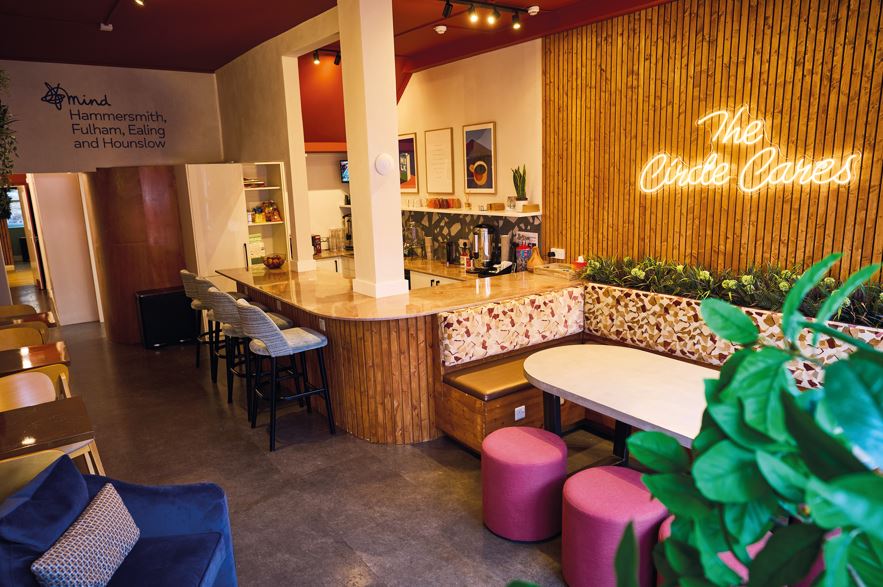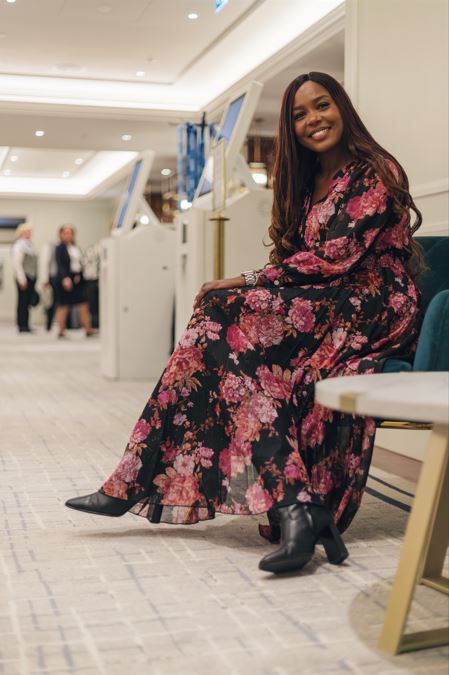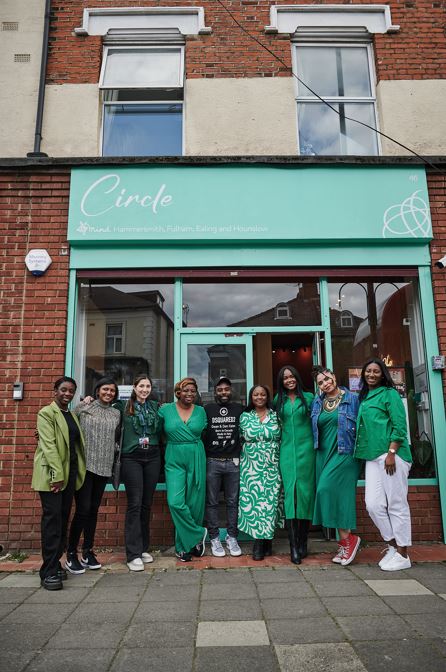
After a successful first year in operation, MIND’s ‘Circle’ crisis support café in London is going from strength to strength. MIND’s Nana Owusu and Meg Wamithi speak to MHDF about their future plans and how new funding is vital to the café’s future.
A new year brings new challenges and young people in the UK are currently facing a crisis of identity as they navigate through life and try to establish their place in the world. The world has changed to such an extent over the past few decades that the challenges of many youngsters are lost on a generation of elders that simply did not face the same issues when growing up.
Fortunately, support offered to those with mental health challenges is growing and there are increasing options for those that are struggling. Growing up in the UK at a time when we face a cost-of-living crisis, political turmoil and a host of other existential issues is certainly not easy. So, what help is out there? Mental health charity MIND is at the forefront of support in this area. Last year, the charity announced the launch of its new crisis support café, ‘Circle’ in Ealing, London, to help children and young people who are experiencing or nearing a mental health crisis. The service is being delivered in partnership with the Northwest London CAMHS Provider Collaborative led by West London NHS Trust, and is the first of its kind in the UK. It provides drop-in and appointment-based specialist mental health support 365 days a year, with the aim of relieving pressure on local A&E departments.
WHAT IS CIRCLE?
Circle has its own dedicated space at 46 South Ealing Road, in Ealing, which has been specially designed to create a welcoming, calm, and safe space with café facilities for local children and young people. The service is staffed with both clinical and non-clinical highly specialised Crisis Support Navigators from HFEH Mind who have a background in CAMHS and crisis care. Young people can self-refer or be referred to Circle by school, social care, A&E, or CAMHS crisis services between 3pm-11pm on weekdays and 12-8pm on weekends. Nationally, the number of under-18s presenting to A&E with a recorded diagnosis of a psychiatric condition has significantly increased (more than tripling between 2010 and 2018-19). However, many of these do not require hospital care. In London in 2021, 50% of young people who attended A&E experiencing a mental health crisis were deemed not to require hospital treatment at that time and discharged home. The fact is that A&E departments are often the only place available to take children experiencing a mental health crisis. Many children do not require hospital care and cannot access the appropriate psychological help there anyway. Circle provides dynamic clinical assessments and more immediate practical help to de-escalate the presenting risk, as well assignpost to other local services. Nana, who is director of children & young people’s services, says, “A&E departments are already overstretched and often not the best place for a young person in crisis who’s already feeling distressed and overwhelmed. Circle provides a much-needed safe space and immediate support for young people who reach a crisis point with their mental health.
STRETCHED NHS SYSTEM
“We’ve seen a big increase in children and young people going to A&E with mental health problems in the last 10 years – but for many of them, A&E isn’t the right place. They don’t require hospital treatment; they need support from trained mental health practitioners to de-escalate in that moment of crisis or distress, and this is where Circle comes in.” With young people facing the very real prospect of falling through the gaps in the face of a stretched NHS system, Nana saw the opportunity to innovate. “We wanted to provide a service where young people were not overwhelmed by bright lights and felt comfortable to talk about their problems in safe a place,” she adds. “They can be retraumatised waitinglong hours in A&E. A lot of young people that present there don’t actually need emergency support. There are other settings that would be better. But the hub has not just been set up as a café. The main goal is crisis prevention, providing a young person with a place to go in their community for help. Meg adds: “It is somewhere that is psychologically safe and where young people are comfortable.” Another exciting aspect in the design of the café was collaboration with young people themselves, providing them with a say in what the establishment would look like. “We worked with them directly,” says Meg. “We had a young people’s board from Hammersmith and Fulham MIND but we also worked really closely with Young Ealing Foundation, who collaborated with interior designer Heartwell Interiors.
Following on from the success of the café, Meg and Nana are now setting their sights on expansion. However – as ever – funding remains an issue. Sustainability is more than just a buzzword and applies to the future of these kind of innovative approaches in the sector. Without support from the industry, it is an uphill battle for care of this nature to survive. “The Circle is only funded for 18 months,” says Meg. “There are amazing services out there, but funding is our biggest issue. “We need to get refunded so that all the people that access it can continue to grow and flourish. The funding officially ends in March 2024.“In terms of sustainability, at the moment the Circle primarily operates as a crisis prevention café but in the daytime, young people can access community programs centred around arts and sports, for example. “We are now hoping that the Circle expands into a one-stop shop where young people can go and access support from early intervention all the way to crisis prevention. The Circle is the first of its kind. But it needs to exist outside of Ealing.” A new café proposal is currently being built in the West End of London following the success of the Circle, which is an exciting prospect. But as yet, plans to ramp up the service into other areas of the country are slow to see action, with financing being a key issue. It is, of course, a huge learning curve for all involved but the intent is there to build on the workthat has been achieved so far. Meg adds: “How can we take all these learnings that we have had and introduce these places around the country? That is the goal. We want it to be so a young person, no matter what their post code, can have somewhere to access free mental health support.”
MEG'S STORY
It always feels like a Back-to-the-Future moment for me, every day I go into work as a lot of the young people that I see are essentially me.
I was that 13-year-old who was presenting at A&E and had a very traumatic experience. Being a young kid and not knowing what is going on inside your head is frightening enough. But going to A&E and seeing all these bright, white lights just makes it worse. I was diagnosed with depression, anxiety and anorexia. I made my first suicide attempt at the age of 14 and my second when I was 16. I went through Child and Adolescent Mental Health Services and then into inpatient support to get my physical health back to where I needed to be, but mental health-wise I don’t think I really got the help I needed until I went into adult services. Fortunately, I had enough money to afford private support and that really helped, enabling me to flourish and be the person I am today. However, it wasn’t until my 20th birthday and my last suicide attempt where I was sectioned that the levels of communication between my GP and local support team enabled me to become home sectioned, which allowed for person-centred care, designed specifically for me. I had to be proactive, however. I was also eventually diagnosed with borderline personality disorder and social anxiety, so I know how tough it can be for these young people, who are extremely vulnerable. This is why I do what I do and my lived experience. My advice to the industry is that ‘you don’t know what you don’t know’. When you design buildings or spaces, speak to us as well. We are not architects for example, but we are programme designers. As a designer of these facilities, clearly you love the work you do. But it is easy to go on assumptions. An idea can be conceptually amazing, but you have to mindful that real people will have to use the space. It is really important to not just include them at the end when it has been built but actually collaborate and coproduce something from the on-set. For me, being able to flourish as I am now is because the mental health support I worked with saw me as a part of the process. I was consulted on what worked best for me and I think with this kind of collaboration, this kind of care can go so far. From my experience at the Circle, the faces of the young people as soon as they walk in is exactly what you want from someone that is in crisis.

